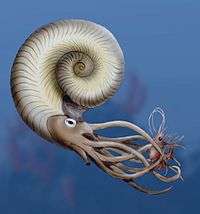Harpoceras
Harpoceras is an extinct genus of cephalopod belonging to the family Hildoceratidae. These cephalopods existed in the Jurassic period, during Toarcian age from Falciferum zone to Commune subzone of Bifrons zone.[3] They were fast-moving nektonic carnivores.[2]

| Harpocerinas | |
|---|---|
| Fossil shell of Harpoceras subplanatum from Isère (France), on display at Galerie de paléontologie et d'anatomie comparée in Paris | |
| Scientific classification | |
| Kingdom: | |
| Phylum: | |
| Class: | |
| Subclass: | |
| Order: | |
| Suborder: | |
| Superfamily: | |
| Family: | |
| Subfamily: | |
| Genus: | Harpoceras Waagen 1869 |
| Type species | |
| Ammonites falcifer Sowerby, 1820 | |
| Species [2] | |
| |
| Synonyms | |
| |
Description
Shells of Harpoceras species show strong dimorphism in their size. While microconchs reach 24–51 mm in diameter, macroconchs shells width is 115–430 mm. They are moderately evolute to involute and compressed. Whorl sides are flat and there is strong keel. Ribs are falcoid or falcate and thus biconcave, strong and projected. Sometimes, ribs can be broad and flat topped on outer part of whorl and in some species they can be striate on inner part of whorl. Some species have midlateral groove, or series of undulating depressions on inner half of whorl.[1][2]
Distribution
Fossils of species within this genus have been found in the Lower Jurassic rocks of Europe, Northern Africa, Russia, Japan, Borneo, New Zealand, Indonesia, North and South America (Argentina; El Cholo and Los Molles Formations).[1] Two species, Harpoceras serpentinum and Harpoceras falciferum, are index fossils used for stratigraphic correlation and dating of rocks of the Toarcian stage of the Lower Jurassic.[4]
References
- M. K. Howarth 2013. Treatise on Invertebrate Paleontology, Part L, Revised, Volume 3B, Chapter 4: Psiloceratoidea, Eoderoceratoidea, Hildoceratoidea.
- Paleobiology Database - Harpoceras. 2017-10-16.
- Sepkoski, Jack Sepkoski's Online Genus Database – Cephalopoda
- Gradstein, F.M.; Ogg, J.G.; Schmitz, M.D.; Ogg, G.M. (editors) (2012). The Geologic Timescale 2012. Elsevier. p. 766. ISBN 978-0-44-459390-0.CS1 maint: uses authors parameter (link)